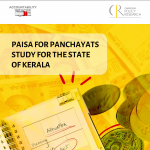
Does the Decentralisation of Administration Work?
14 August 2020
This blog is part of a series that explores the conceptual underpinnings of decentralisation. The first part was published on 17 June 2020. The previous blog can be found here.
One of the interests that has been most resistant to democratic decentralisation has been the administration, comprising bureaucrats, usually recruited and deployed by the State governments. Let’s understand why through the ‘3F’ formula of decentralisation.
First, it is expected that functions are disentangled and allocated to different levels of government (including local governments), with a reasonable level of clarity. Then, it is expected that the funding streams of the government are separated on the basis of the functional assignments undertaken, and allocated to local governments. Alongside, tax handles are assigned to each for collection and appropriation of the proceeds, so that both steps together ensure that local governments have enough fiscal resources to carry out their functions effectively.
The third ‘F’ refers to ‘functionaries’, which constitute the organisational and manpower capacity of the local government to carry out their functions. Here too, conventional tactics are either to give local governments the power to hire, fire and hold to account their staff, or to break up traditionally centralised bureaucracies and transfer a reasonable modicum of control over the staff to local governments.
In India, the government is still seen as offering the gold standard of employment.
In India, while the formal political statement in favour of decentralisation is expressed in lofty terms, functional assignments are decidedly hazy. Fiscal decentralisation is abysmal, with very little match to the functions assigned, and with most funding tied down to the performance of agency functions. Even the meagre amounts that are devolved as flexible grants, are clawed back by the State, and control over the same is vested with higher-level officials.
When it comes to the powers of local governments to hire and fire staff, this is virtually non-existent. Over the years, including the period after the enactment of the 73rd and 74th amendments that constitutionally mandate the establishment and empowerment of elected local governments, the system has regressed, rather than progressed.
Prud’homme, whose critique of decentralisation was what I analysed in the past few blogs, also has misgivings about the idea of breaking up centralised bureaucracies and assigning their fragments to local governments. He believes that decentralisation often leads to capacity constraints, which turn insurmountable, in the context of developing countries, wherein any case capacities are below par at all levels of government.
He argues that in contexts where overall capacities are poor and there is a net deficit of capacities regardless of the level of government, it is not prudent to dismantle central bureaucracies and assign them to local governments. Prud’homme believes that central bureaucracies also may be more efficient providers than local bureaucracies because the former are more likely to attract more qualified people because they offer better careers, with a greater diversity of tasks, more possibilities of promotion, less political intervention, and a longer view of issues.
Additionally, according to him, central government bureaucracies (in our federal context that would also include State government bureaucracies) are likely to invest more than local bureaucracies in technology, research, development, promotion and innovation. Thus, he avers, contracting of central activities and transfer of them to local bureaucracies comes at a cost; of undermining the strength of central bureaucracies.
An examination of the diverse and constantly changing contexts in India shows that some aspects of Prud’homme’s fears ring true. In India, where there is a huge unorganised sector with little rights for the worker, and the pressure on employment in the organised sector is so high that those who make the grade are hardly in a position to engage in collective bargaining for their rights, it is the government that is still seen as offering the gold standard of employment.
Here, in the government, are jobs that employ the entrant for life, with a predictable and graded career growth and with an assured pension calculated on well-known formulae waiting at the end, when the employee retires. In an uncertain world, that assurance is highly valued by the job seeker. Even discounting the malafide reasons underlying why some people at least join the government, such as corruption, a government job is seen as prestigious, offering assured security and a predictable career progression.
It is thus only natural that hackles are raised when any thought of breaking up this bureaucracy and assigning it to local governments is considered by the pro-decentralisation reformer. The horizontal splitting of the bureaucracy into self-contained packages assigned to local governments, at one stroke, destroys the prospects of career growth and also sends a signal that the pensions that await the retired officer are not so assured after all. Little wonder, that staff unions stiffly resist any such move to split the bureaucracy and assign them to local governments.
One way to overcome this, adopted in the past, was the ploy to declare certain cadres of the bureaucracy, mainly frontline workers, as ‘dying cadres’. The idea was that if recruitment to certain cadres was stopped at the State level, and fresh recruitments were undertaken only at the local level, then over a period of time, older officials resistant to the idea of moving over to work under the control and superintendence of the local governments would retire. They would be replaced by a new class of officials who were recruited at that level and therefore, were presumably comfortable with working at that level.
Yes, that was tried, and that stated objective was not achieved. Not by a long shot.
Wherever such steps were taken, for example, in Madhya Pradesh, the local recruits quickly formed unions, and then pressurised the government to elevate them to the status of State employees, so that they would have access to promotional opportunities and an assured pension, much like their earlier recruited colleagues who were in the State service.
Are there ways by which this conundrum can be solved? There are no cut and dry answers to that question. However, some approaches may hold some promise. More of that in my next blog.
T.R. Raghunandan is an Advisor at Accountability Initiative.





